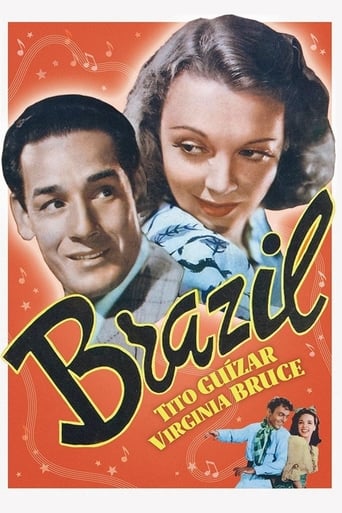The Musical Love Story of Pan-America!
Brazil is perhaps the best of the handful of US films made by Brazilian singing sensation Tito Guizar. In typical screwball-comedy fashion, the plot is set in motion by authoress Nicky Henderson, who has hit the best-seller charts with her latest tome, Why Marry a Latin? While researching her next book in Rio De Janeiro, she finds out "why" when she meets handsome songwriter Miguel Soares. Upon learning about Nicky's book, Miguel decides to teach her a few lessons in the affairs of the heart. Edward Everett Horton is also on hand, twittering his way through the role of a well-meaning buttinsky. Thanks to the "Good Neighbor" policy of the 1940s, South American musicals were a glut on the market, but Brazil was good enough on its own merits to pay its way at the box office.
"Brazil" (1944), produced by Republic Pictures in the United States, is a vibrant and colorful musical film that captures the essence of Brazilian culture and the allure of its landscapes. Directed by Joseph Santley, the film stars Tito Guízar, Virginia Bruce, and Edward Everett Horton, and it was crafted during a time when Hollywood sought to celebrate and explore international cultures. The plot follows a talented singer, played by Guízar, who travels to Brazil to perform and ends up embroiled in a romantic and musical adventure. The film's use of Technicolor brings to life the lush scenery and energetic dance sequences, making it a visual feast that transports viewers to the heart of South America. The storyline of "Brazil" is a delightful blend of romance, comedy, and music, set against the backdrop of Rio de Janeiro's iconic landmarks and the lively atmosphere of Carnival. The narrative weaves together the singer's journey with a charming love triangle and humorous misunderstandings, all underscored by an array of catchy songs and samba rhythms. The film's musical numbers, featuring authentic Brazilian tunes and dances, are a highlight, showcasing the talents of the cast and the vibrant spirit of Brazilian culture. The performances by Guízar and Bruce, in particular, add depth and warmth to the film, making it an engaging and entertaining watch. In addition to its entertainment value, "Brazil" serves as a cultural ambassador, introducing American audiences to the richness of Brazilian traditions and the beauty of its people. The film's depiction of Brazil, while somewhat idealized, reflects the fascination and admiration that Hollywood had for foreign cultures during the 1940s. The inclusion of scenes showcasing Brazilian daily life, from street markets to samba parades, adds authenticity and depth to the film's setting. This cultural exchange was part of a broader trend in American cinema at the time, aimed at fostering international understanding and goodwill. Overall, "Brazil" (1944) is a charming and visually stunning film that successfully blends Hollywood's storytelling with the vibrant culture of Brazil. Its engaging plot, memorable musical numbers, and colorful portrayal of Brazilian life make it a standout example of the era's international-themed films. While it may not be a comprehensive or entirely accurate representation of Brazil, the film captures the spirit and joy of the country in a way that continues to entertain and delight audiences.
Año1944
Duración91 minuto
GénerosComediaRomanceMúsica
Países de producciónUnited States of America

